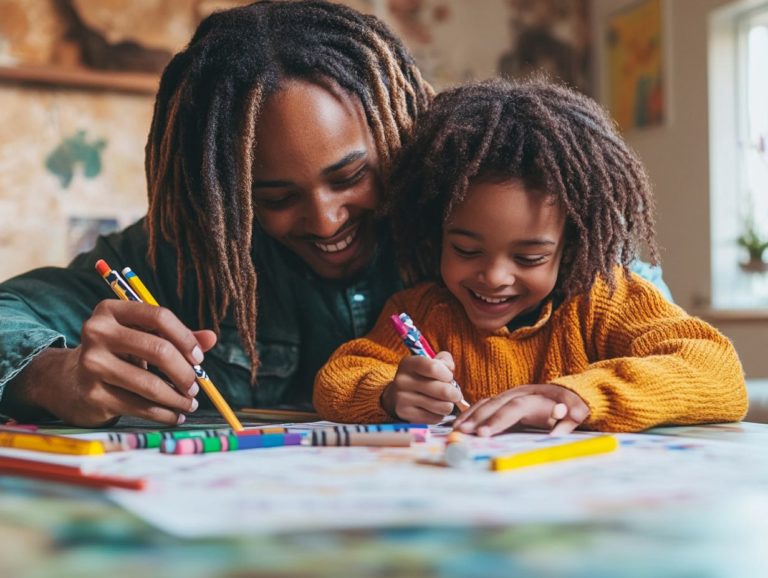Family Meditation: Tips for Beginners
In today s fast-paced world, carving out quality time to connect with your family can often feel like an uphill battle. Family meditation is a fantastic way to build stronger connections and create a calm home environment, which is essential for effective parenting and child development.
This article delves into the significance of family meditation, offering practical steps to embark on this journey, tips for engaging your children in kids meditation, and strategies for navigating common challenges.
Explore how you can create moments of mindfulness together using mindfulness meditation and unlock the profound benefits that arise from meditating as a family.
Contents
- Key Takeaways:
- Why is Family Meditation Important?
- How to Start Family Meditation?
- What are the Benefits of Family Meditation?
- What are Some Tips for Engaging Children in Family Meditation?
- Common Challenges in Family Meditation and Solutions
- 1. Distractions and Restlessness
- 2. Resistance from Family Members and Anxiety Management
- 3. Finding Time and Consistency in Your Meditation Routine
- Frequently Asked Questions
Key Takeaways:

- Family meditation provides numerous benefits such as strengthening bonds, reducing stress, managing anxiety, and promoting mindfulness.
- To start family meditation, set a regular time and place, choose a comfortable position, and use guided meditations or calming music.
- To engage children in family meditation, make it fun and interactive, keep it short and simple, use creative visualization, and encourage open communication and feedback to foster self-regulation and emotional balance.
Why is Family Meditation Important?
Family meditation is a critical practice for today s families, as it enriches emotional health, fortifies family bonds, and cultivates a serene home environment conducive to personal growth and mental health.
By committing to daily meditation routines, you and your children can nurture mindfulness together. This practice helps manage stress and anxiety while fostering personal growth and inner peace, significantly contributing to anxiety management and stress relief.
This approach enhances not only your individual emotional balance but also fosters healthy relationships, creating a supportive atmosphere where your children can flourish and develop vital ways to handle stress and breathing techniques for life’s inevitable challenges.
How to Start Family Meditation?
Embarking on a family meditation practice can be both enjoyable and rewarding. It significantly enhances your family’s emotional health and deepens the connections between parents and children.
Establishing a regular evening routine, choosing a peaceful space, and leveraging meditation apps like Headspace or Calm can seamlessly weave mindfulness techniques into your daily life. These apps offer a wide range of guided meditations and calming techniques that cater to different needs, including stress management and anxiety reduction.
Incorporating guided meditations, breathing exercises, and relaxation techniques designed specifically for kids fosters a positive atmosphere that encourages engagement and focus during your family meditation sessions. Techniques such as body scan meditation and mantra meditation are particularly effective.
1. Set a Regular Time and Place
Establishing a regular time and place for family meditation is essential for creating a reliable mindfulness practice that everyone can embrace. By designating a quiet space in your home, free from distractions, you set the scene for focused and effective sessions that promote emotional balance and relaxation.
Choosing specific times, like early mornings or evenings, allows everyone in the family to seamlessly integrate meditation into their daily routine. Consider locations such as a cozy corner of the living room or a tranquil backyard where the soft sounds of nature can enhance the experience.
To cultivate a serene atmosphere, think about using soft lighting, comfortable seating, and calming scents from essential oils or candles. This intentional setting not only makes the experience more inviting but also reinforces the habit, enabling each participant to deepen their mindfulness practice and strengthen their connection with one another over time.
Start your family s mindfulness journey today!
2. Choose a Comfortable Position
Choosing a comfortable position is crucial for effective family meditation, as it enables you and your loved ones to relax and fully immerse yourselves in the practice. Whether you prefer sitting cross-legged on a mat, lying down for a body scan meditation, or opting for supportive chairs, prioritizing comfort will enhance your focus and promote emotional well-being. This approach can also help with time management during your meditation sessions.
Each of these positions can profoundly influence your mindfulness and relaxation experience. For instance, sitting cross-legged encourages an open posture, fostering alertness and connection among family members. On the other hand, lying down might invite deeper introspection and a comforting sense of security, making it ideal for those looking to unwind. Supportive chairs can provide stability and comfort, particularly for younger children or individuals with mobility concerns. These adjustments can also pave the way for better sleep improvement and inner peace.
You are encouraged to experiment with these varied techniques and positions, allowing each family member to discover their perfect setup. This exploration ultimately enriches your collective meditation experience, creating a more harmonious and fulfilling journey together. Such practices also enhance your present moment awareness and focus improvement, making each session more impactful.
3. Set an Intention
Setting an intention for each family meditation session can profoundly elevate your practice, offering a clear focus and purpose that resonates with everyone involved. Whether you re aiming for stress relief, emotional balance, heart health, or cultivating loving kindness, sharing these intentions fosters deeper connections and a heightened sense of mindfulness within your family.
Take a moment to articulate these intentions aloud; this allows each family member to voice their hopes and aspirations for the session, establishing a positive atmosphere that permeates the gathering. Themes like loving kindness invite warmth and compassion, while a focus on emotional balance encourages a sense of inner harmony. This habit also supports mental health and emotional support within the family.
By establishing and communicating these shared intentions, you create a supportive environment that nurtures both individual and collective growth. This practice doesn t just enrich the meditation experience; it also promotes understanding and empathy among your loved ones, ultimately leading to stronger familial bonds and a shared journey toward mindfulness.
4. Use Guided Meditations or Music
Incorporating guided meditations or calming music into your family meditation sessions can truly elevate relaxation and focus while nurturing emotional well-being. With meditation apps like Headspace and Calm at your fingertips, you have access to a wealth of resources designed for both kids and adults, all aimed at creating a serene meditation experience. These apps often include features like breathing techniques and relaxation methods tailored to various age groups, making family sessions more inclusive and effective.
These platforms come equipped with features tailored to various moods and age-appropriate content, making it a breeze for your family to engage in mindfulness together. Imagine integrating soothing music, like nature sounds or gentle instrumental tracks, to enhance that tranquil atmosphere. Playlists featuring artists such as Ludovico Einaudi or selections from the ‘Peaceful Piano’ Spotify playlist can serve as the perfect backdrop to set the mood. For more spiritual families, incorporating biblical meditation or Christian themes can add a unique dimension to the practice.
Utilizing these resources allows your family not only to deepen your meditation practice but also to strengthen emotional connections, fostering a shared space for mindfulness and relaxation. This approach can also lead to sleep improvement and better time management within the family.
What are the Benefits of Family Meditation?

Family meditation offers a wealth of benefits that elevate emotional well-being and reinforce family bonds. It cultivates mindfulness among every member and provides numerous health benefits, like improved heart health and mental health.
With consistent practice, you ll notice significant reductions in stress and anxiety. You may also experience enhanced communication and a deeper sense of connection within your family.
This journey nurtures personal growth and creates a healthier, more harmonious home environment, contributing to better anxiety management and overall emotional balance.
1. Improves Family Bonding
One of the significant benefits of family meditation is its remarkable ability to enhance family bonding, as it fosters open communication and emotional support among all members. By engaging in this mindful practice together, you can cultivate deeper connections, creating an atmosphere of trust and understanding.
This collective practice can improve not only emotional support but also heart health and mental health. As you sit side by side in a serene space, you share experiences that promote empathy and active listening essential ingredients for nurturing supportive interactions.
For instance, you might discover that while meditating, your family feels more comfortable expressing their feelings and fears in a safe, judgment-free environment. This can improve self-regulation and emotional well-being.
This shared journey not only builds resilience but also nurtures a collective commitment to mindfulness, transforming the way you perceive and support one another. This unity ultimately results in better coping strategies and stress management for everyone involved.
The simple act of meditating together can rekindle a sense of unity, forming an emotional foundation that elevates your relationships beyond the everyday hustle and bustle. Start practicing today to transform your family dynamics!
2. Reduces Stress and Anxiety
Looking to reduce stress and anxiety? Family meditation is the perfect solution! It plays a vital role in this by introducing relaxation techniques that allow you and your loved ones to engage with your emotions more effectively.
As you practice mindfulness together, you ll discover invaluable coping strategies that enhance emotional balance and alleviate the daily pressures of life. These strategies also contribute to better mental health and anxiety management.
This shared practice often incorporates techniques such as guided imagery, deep breathing, and progressive muscle relaxation, all of which help cultivate a profound sense of inner peace. For instance, one family revealed that by dedicating time to a weekly meditation session, they managed to transform their chaotic evenings into serene moments of connection.
They found themselves more attuned to each other’s needs, fostering improved communication and understanding. These techniques are not only beneficial for emotional well-being but also for long-term heart health and overall relaxation response.
Stories like this highlight how shared mindfulness experiences can enable families to build deeper emotional resilience, allowing them to navigate life’s challenges with greater ease. These moments of collective calm not only diminish anxiety but also strengthen familial bonds, creating a nurturing environment where every member can flourish and cultivate inner peace.
Enhancing Communication and Understanding
Engaging in family meditation significantly enhances communication and understanding among family members, creating an atmosphere where everyone feels comfortable expressing their feelings openly.
This practice encourages mindfulness techniques, including guided meditation (a process where one is led through meditation by a voice or audio) and breathing exercises, enabling you to navigate challenging conversations with both empathy and clarity.
By setting aside dedicated time for meditation, you and your family members can practice active listening and build a deeper sense of emotional support for one another.
For instance, try adding a weekly check-in meditation session, where each person shares their thoughts or feelings while the others listen attentively, without interruption.
This approach not only fosters a culture of open dialogue but also affirms each individual’s experiences, validating the diverse emotions within your family.
Incorporating visualization exercises can further help family members project love and understanding toward one another, reinforcing the bonds that hold your family unit together.
Such practices create a supportive space that encourages vulnerability and fortifies your family’s emotional resilience.
Promoting Mindfulness
Family meditation serves as a powerful tool for promoting mindfulness, inviting each member to embrace the present moment and enhance their self-awareness.
This enriching practice not only bolsters emotional well-being but also paves the way for personal growth, enabling families to confront life’s challenges with a mindful perspective.
By establishing a shared space for reflection and connection, you can build stronger bonds while fostering an atmosphere of understanding and empathy.
Engaging in mindful practices such as deep breathing exercises, guided meditation, and guided imagery allows individuals to release negative emotions and build resilience.
Try adding fun routines like weekly meditation sessions, daily practice, or gratitude journaling into your family’s life.
These activities create a supportive environment where every member can openly express their feelings.
Over time, incorporating these techniques can profoundly transform family dynamics, encouraging open communication and deepening emotional connections among loved ones.
What are Some Tips for Engaging Children in Family Meditation?
Engaging your children in family meditation can be a truly rewarding journey that nurtures their emotional well-being and instills mindfulness from an early age.
Kids meditation can be particularly beneficial in promoting emotional balance and self-regulation.
By transforming meditation into a fun and interactive experience, you can cultivate an environment where your kids feel at ease exploring their thoughts and emotions, all while embracing the practice of mindfulness.
1. Make it Fun and Interactive
To truly engage children in meditation, it s essential to infuse the experience with fun and interactivity, weaving in playful elements that resonate with their interests.
By incorporating games, stories, or music, you can create an enjoyable atmosphere that captures their attention and enhances their mindfulness journey.
Using meditation apps like Headspace or Calm specifically designed for kids can also be beneficial.
Consider introducing themed meditation sessions centered around popular children s stories or characters.
This approach allows kids to visualize and immerse themselves in those narratives, making the practice more relatable.
For instance, guiding a meditation inspired by a beloved animated film can ignite their imagination and help maintain focus.
Integrating movement activities like yoga poses or nature walks combines physical play with mindfulness, making the experience dynamic and engaging.
This way, you can bond as a family through shared creativity, transforming meditation into an adventure that nurtures both relaxation and connection.
Yoga not only promotes physical health but also enhances mental health, making it a wholesome activity for the family.
2. Keep it Short and Simple

Keeping family meditation sessions short and simple is essential for capturing children’s attention and maintaining their interest. This ensures that the experience remains both enjoyable and effective. A 5 to 10-minute session serves as an ideal starting point, allowing your kids to gradually familiarize themselves with mindfulness techniques. You can also extend the sessions over time to turn these short practices into a regular meditation routine.
By incorporating brief and engaging practices like guided breathing exercises or visualization you can cultivate a nurturing atmosphere for meditation. For example, encouraging your children to count their breaths or imagine a serene scene can be incredibly effective. These techniques not only accommodate their shorter attention spans but also promote a sense of calm and presence. Using a simple word or phrase to help focus their thoughts can also assist in deepening their meditation practice.
Tailoring the style and duration to suit each child’s preferences allows for a more personalized approach, helping them stay engaged and fully benefit from the practice without feeling overwhelmed.
3. Use Creative Visualization
Incorporating creative visualization into your child’s meditation practice can truly captivate their imagination and elevate their mindfulness experience, making it more engaging and relatable. By guiding them through imaginative scenarios, you can help them connect with their emotions and foster a deeper understanding of mindfulness. This practice also enhances their emotional well-being and promotes child development.
Picture this: envisioning a serene beach where your child can build their own sandcastles encourages them to visualize peace and creativity while nurturing their sense of tranquility. Alternatively, imagine taking them on a journey through a magical forest filled with friendly animals, sparking their excitement and curiosity while promoting a sense of safety and wonder.
These themes resonate beautifully with children’s interests and play a crucial role in enhancing their emotional intelligence. Engaging in these imaginative exercises fosters relaxation and focus, transforming family meditation sessions into a delightful yet meaningful experience. Through these visualizations, your child learns to harness the power of their imagination, contributing significantly to their overall emotional well-being.
4. Encourage Open Communication and Feedback
Encouraging open communication and feedback during family meditation sessions creates a nurturing environment where you and your children feel genuinely heard and valued. This practice allows your family to explore experiences, emotions, and thoughts about meditation, ultimately enriching your collective mindfulness journey. Including relaxation techniques can further support this process by helping everyone feel more at ease during discussions.
By establishing a regular routine of sharing feelings and reflections, you can deepen connections within your family, fostering a greater understanding of each other s perspectives. After each session, setting aside a few minutes for discussion can be incredibly beneficial. It provides an opportunity for everyone adults and children alike to articulate their insights and any challenges encountered during meditation. This approach can significantly aid in stress management and anxiety reduction for the entire family.
This practice emphasizes the importance of expressing emotions and cultivates empathy among family members as they listen to one another’s unique experiences. Offering constructive feedback reinforces positive feelings, making each member feel supported and encouraging ongoing engagement in mindfulness practices.
Common Challenges in Family Meditation and Solutions
While family meditation brings a wealth of benefits, it can also introduce challenges that you and your family must navigate to maintain a consistent practice. Integrating daily meditation into your routine can help establish a more consistent practice.
Common obstacles include distractions, reluctance from some family members, and the struggle to carve out time for group meditation. However, with effective coping strategies, such as time management and creating a calming environment, you can overcome these barriers and cultivate a rewarding practice together.
Don t wait! Start incorporating these fun visualization techniques today to see your child s meditation journey flourish! Try these techniques in your next family session and witness the joy it brings!
1. Distractions and Restlessness
Distractions and restlessness can pose significant challenges during family meditation sessions. They often make it difficult for everyone to focus and engage fully.
To counter this, try implementing calming techniques such as breathing exercises, mindfulness activities, or creating a serene environment that minimizes disturbances.
In addition to these techniques, it s wise to identify specific distractions that might disrupt the tranquility of your sessions. Common interruptions include noise from electronic devices, nagging unfinished tasks lingering in your mind, or the relentless pace of daily life.
To effectively combat these disruptions, set a regular time and place for meditation. This way, you can ensure that devices are silenced and distractions are set aside. Creating a quiet space specifically for meditation can enhance focus and the relaxation response during your sessions.
Incorporating short, themed meditation sessions that resonate with family life can significantly enhance engagement. This approach allows members to relate better to the themes, keeping their focus intact. By fostering an atmosphere imbued with calmness and openness, your family is likely to experience a deeper connection and tranquility during meditation practices.
This can also contribute to overall stress relief and emotional support within the family unit.
2. Resistance from Family Members and Anxiety Management
Resistance from family members can present a significant hurdle when you re trying to establish a successful family meditation practice, especially if some are skeptical or simply uninterested.
To navigate this challenge, it s essential to foster open communication and provide emotional support, creating a more inclusive and engaging experience for everyone involved. Try meditation apps like Headspace or Calm to guide your practice.
Understanding the underlying reasons for this resistance is key; it might be rooted in misconceptions about meditation, time constraints, or unfamiliarity with its benefits such as stress management and anxiety reduction.
To address these concerns, cultivate an atmosphere of dialogue where each family member feels comfortable expressing their thoughts and feelings. Engage in brief discussions about meditation, share your personal experiences, and invite a family member to join you in a low-pressure setting.
Techniques such as guided meditation, where a narrator leads you through visualization techniques, or mantra meditation can be introduced to find what resonates with them.
By acknowledging their feelings, demonstrating empathy, and offering reassurance, you can create a supportive environment that makes it easier for everyone to explore how meditation can enhance family dynamics.
3. Finding Time and Consistency in Your Meditation Routine
Finding time and maintaining consistency in family meditation can indeed be quite the challenge, especially with your busy schedules and competing priorities.
By implementing effective time management strategies and incorporating calming techniques, such as weaving meditation into your existing routines or designating specific days for practice, you can establish a rhythm that promotes a consistent family meditation schedule.
To increase your chances of success, consider dedicating a few minutes each morning or evening to mindfulness sessions. These moments can transform into cherished bonding opportunities that strengthen family ties.
Utilizing a family calendar to mark meditation times serves as a visual reminder of this shared goal, reinforcing its significance in your lives. After each session, discussing your experiences can further solidify the practice’s value, helping meditation become a more integrated part of your daily routine.
You could also explore specific techniques like body scan meditation or breathing exercises for varied experiences.
As you build consistency over time, you ll likely notice the positive effects of mindfulness permeating your family s communication and overall well-being. This practice can contribute to mental health and emotional balance, creating a more peaceful home environment.
Understanding Family Meditation Styles

Navigating the diverse meditation styles and preferences within your family can pose challenges when trying to establish a cohesive practice.
Encourage open discussions for a richer family experience!
Each family member may have unique inclinations, so exploring various mindfulness techniques is beneficial. This approach helps find common ground and fosters emotional support among family members. Engaging in methods like loving kindness or biblical meditation a form of meditation that draws from biblical texts could also be advantageous.
For instance, some family members might enjoy guided meditations, while others may prefer the tranquility of silent reflection or the dynamic flow of movement-based practices like yoga. By organizing family meditation sessions that alternate between these different approaches, everyone can feel included and valued in the practice.
You may want to consider stress relief and anxiety management techniques like breathwork a method focusing on conscious breathing and visualization imagining positive scenarios to create a calming effect.
Consider integrating elements from various styles, such as incorporating breathwork into a traditional sitting meditation. This flexibility allows each individual to resonate with the practice in their own unique way.
Embracing a variety of techniques not only broadens your understanding and appreciation of mindfulness but also cultivates a nurturing environment, helping family members develop greater empathy and openness to each other’s experiences.
Don t hesitate to use meditation apps for added guidance and support!
Frequently Asked Questions
What is Family Meditation?
Family meditation is the practice of meditating together as a family unit. It involves setting aside a specific time to sit in silence, focus on breathing, and cultivate inner peace and mindfulness as a family. This practice can include various techniques such as mindfulness meditation, mantra meditation repeating a word or phrase to aid focus and body scan meditation.
Why is Family Meditation Beneficial?
Family meditation has numerous benefits!
It helps family members connect on a deeper level, reduces stress and anxiety, improves communication and conflict resolution skills, and promotes overall well-being.
Additional health benefits might include heart health, sleep improvement, and enhanced emotional well-being.
How Do I Get Started with Family Meditation?
To get started, find a quiet and comfortable space, set a specific time for your practice, and decide on a meditation technique that works for everyone, such as focusing on breath, visualization, or guided meditation.
Start with short sessions, gradually increasing the duration as you become more comfortable. Incorporating breathing techniques and relaxation techniques can also be helpful for beginners!
What Are Some Tips for Practicing Family Meditation with Children?
When practicing family meditation with children, keep sessions short and engaging.
Use fun and creative techniques like visualization or body movements to capture their attention.
You can also introduce meditation for kids through kids meditation apps and stories. Setting a positive example by regularly practicing meditation yourself is also beneficial.
Can Family Meditation Be Done with All Family Members?
Yes! Family meditation can be practiced with all family members, regardless of age or physical ability.
It’s important to be flexible and accommodating to everyone’s needs and limitations. You can modify the practice to suit individual preferences, such as incorporating music or using different meditation techniques.
Introducing calming methods and creating a peaceful environment makes the experience more pleasant for everyone.
How Can We Make Family Meditation a Regular Habit?
To make family meditation a regular habit, set a specific time and place for your practice, commit to it as a family, and hold each other accountable.
Try different techniques, incorporate gratitude or reflection, and celebrate your progress together.
Establishing a daily practice and integrating it into your evening routine can reinforce the habit.
Ready to start your family meditation journey? Let s dive in!


